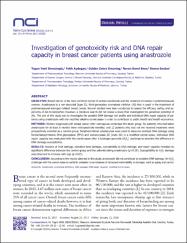| dc.contributor.author | Yeşil Devecioğlu, Tuğçe | |
| dc.contributor.author | Aydoğan, Fatih | |
| dc.contributor.author | Omurtag, Gülden Zehra | |
| dc.contributor.author | Şenel Bese, Nuran | |
| dc.contributor.author | Sardaş, Semra | |
| dc.date.accessioned | 10.07.201910:49:13 | |
| dc.date.accessioned | 2019-07-10T20:02:09Z | |
| dc.date.available | 10.07.201910:49:13 | |
| dc.date.available | 2019-07-10T20:02:09Z | |
| dc.date.issued | 2018 | en_US |
| dc.identifier.citation | Devecioğlu, T. Y., Aydoğan, F., Omurtag, G. Z., Şenel Bese, N. ve Sardaş, S. (2018). Investigation of genotoxicity risk and DNA repair capacity in breast cancer patients using anastrozole. Northern Clinics of Istanbul, 5(1), 6-13. https://dx.doi.org/10.14744/nci.2017.55822 | en_US |
| dc.identifier.issn | 2148-4902 | |
| dc.identifier.uri | https://dx.doi.org/10.14744/nci.2017.55822 | |
| dc.identifier.uri | https://hdl.handle.net/20.500.12511/3564 | |
| dc.description | WOS: 000433094100003 | en_US |
| dc.description | PubMed ID: 29607425 | en_US |
| dc.description.abstract | OBJECTIVE: Breast cancer is the most common cancer in women worldwide and the incidence increases in postmenopausal women. Anastrozole is a non-steroidal (type II), third-generation aromatase inhibitor (AI) that is used in the treatment of postmenopausal estrogen-related breast cancer. Several studies have been conducted to assess the efficacy, safety, and superiority of AIs to tamoxifen; however, a literature search did not reveal a study that investigated the genotoxic potential of AIs. The aim of this study was to investigate the possible DNA damage risk profile and individual DNA repair capacity of patients using anastrozole with the modified alkaline comet assay in order to contribute to public health and health economics. METHODS: Women diagnosed with breast cancer after menopause comprised the study group. Six patients who had taken anastrozole for at least 6 months were retrospectively enrolled, and 12 patients who had not yet received treatment were prospectively enrolled as a control group. Peripheral blood lymphocytes were used to measure oxidized DNA damage using formamidopyrimidine DNA-glycosylase (FPG) and endonuclease III (endo III) in a modified comet assay. Individual DNA repair capacity was evaluated with the comet assay after a hydrogen peroxide (H2O2) challenge to examine the difference in DNA damage susceptibility. RESULTS: Analysis of DNA damage, oxidative base damage, susceptibility to DNA damage, and repair capacity revealed no significant difference between the control group and the patients taking anastrozole (p>0.05). Susceptibility to H2O2 damage was observed to increase with age (p<0.05). CONCLUSION: According to the results obtained in this study, anastrozole did not contribute to oxidative DNA damage. An H2O2 challenge with the comet assay is useful to evaluate circumstances of increased vulnerability to damage, such as aging and cancer. | en_US |
| dc.description.sponsorship | Research Foundation of Marmara University [SAG-C-YLP-211009-0313] | en_US |
| dc.description.sponsorship | This study was supported by Research Foundation of Marmara University (grant no: SAG-C-YLP-211009-0313). | en_US |
| dc.language.iso | eng | en_US |
| dc.publisher | Kare Publishing | en_US |
| dc.rights | info:eu-repo/semantics/openAccess | en_US |
| dc.subject | Anastrozole | en_US |
| dc.subject | Aromatase Inhibitors | en_US |
| dc.subject | DNA Damage | en_US |
| dc.subject | DNA Repair Capacity | en_US |
| dc.subject | Modified Comet Assay | en_US |
| dc.title | Investigation of genotoxicity risk and DNA repair capacity in breast cancer patients using anastrozole | en_US |
| dc.type | article | en_US |
| dc.relation.ispartof | Northern Clinics of Istanbul | en_US |
| dc.department | İstanbul Medipol Üniversitesi, Eczacılık Fakültesi, Eczacılık Meslek Bilimleri Bölümü, Farmasötik Toksikoloji Ana Bilim Dalı | en_US |
| dc.identifier.volume | 5 | en_US |
| dc.identifier.issue | 1 | en_US |
| dc.identifier.startpage | 6 | en_US |
| dc.identifier.endpage | 13 | en_US |
| dc.relation.publicationcategory | Makale - Uluslararası Hakemli Dergi - Kurum Öğretim Elemanı | en_US |
| dc.identifier.doi | 10.14744/nci.2017.55822 | en_US |


















